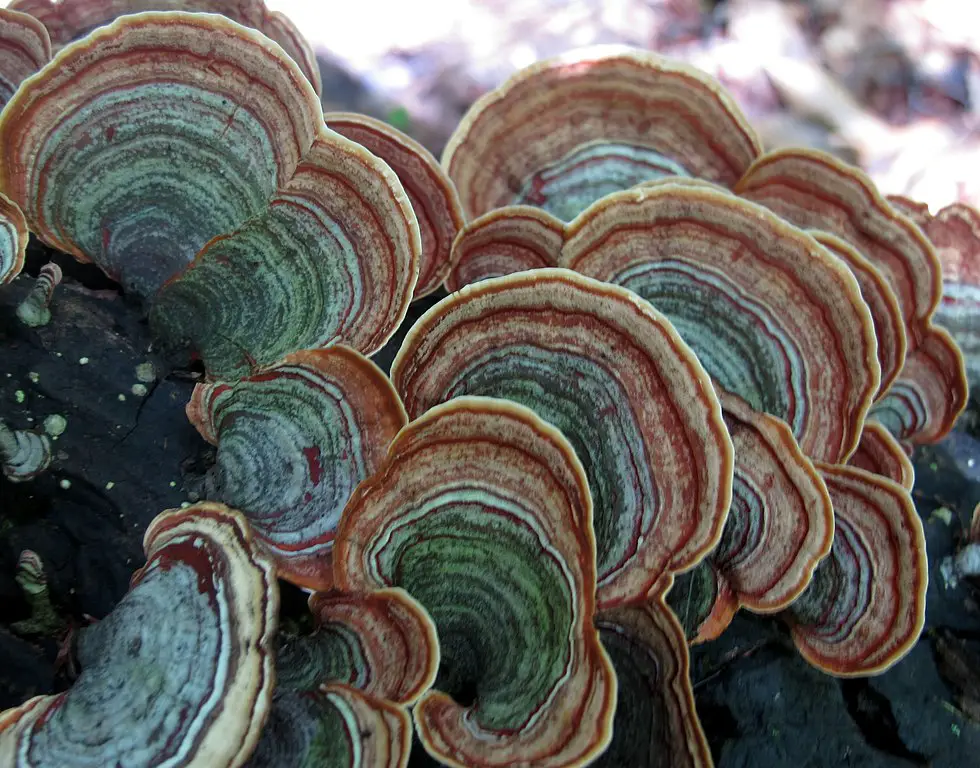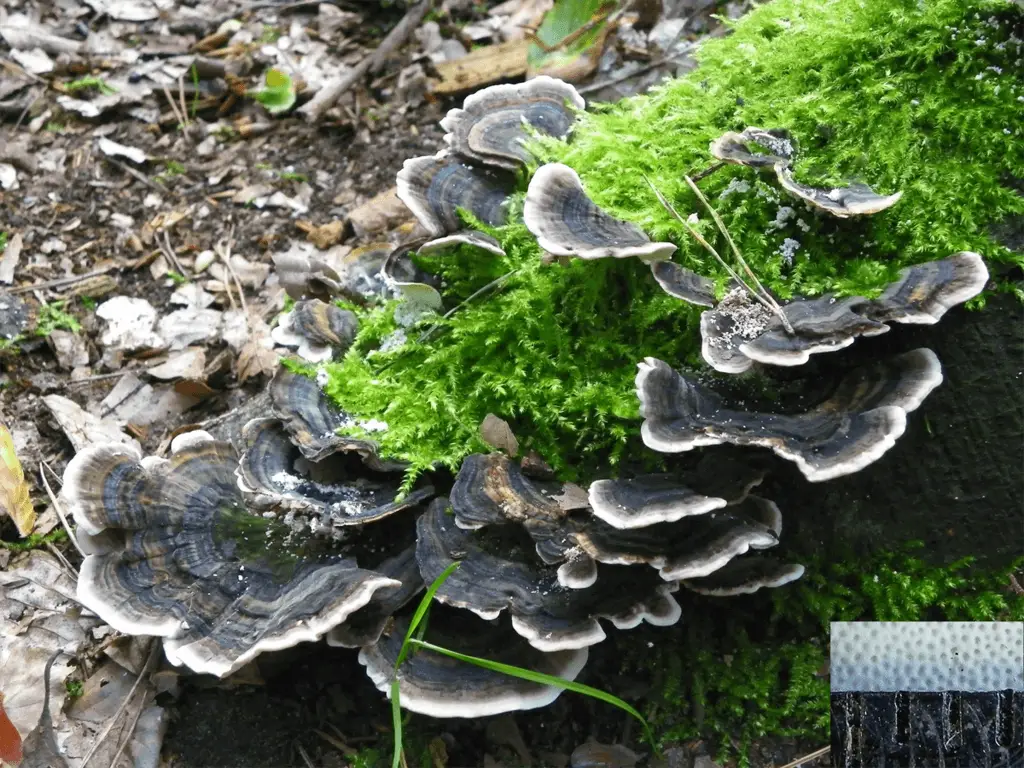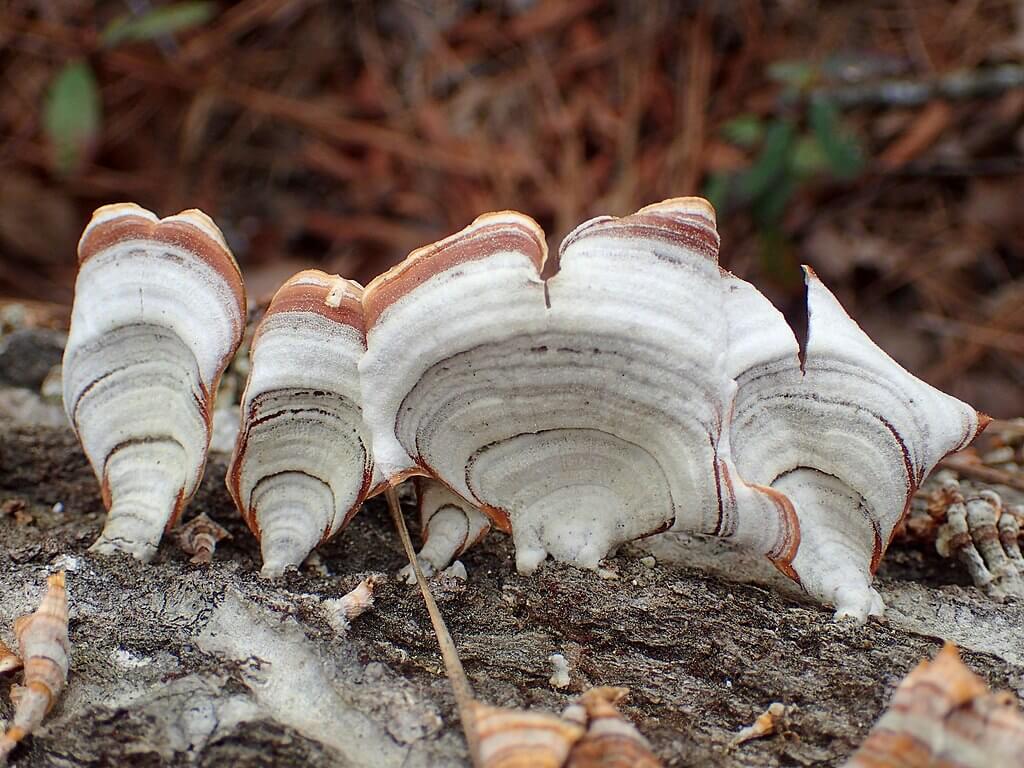True turkey tail (Trametes versicolor) holds its spores in tubes, so you should see tiny holes visible to the naked eye. The false turkey tail (Stereum ostrea) has a smooth or slightly wrinkly underside and no visible pores.
False turkey tail (Stereum ostrea) is a plant pathogen and a wood decay fungus; it bears concentric circles of many colors that closely resemble the Trametes versicolor, turkey tail, and is therefore called ‘false turkey-tail’.
False turkey tail profile
| Scientific name | Stereum ostrea |
| Family name | Stereaceae |
| Plant type | Basidiomycete fungus |
| Kingdom | Fungi |
| Genus | Stereum |
| Phylum | Basidiomycota |
Common name:
- golden curtain crust
False turkey tail is an extremely common and widely distributed bracket fungus that decomposes wood. As a rule, individual brackets develop in overlapping patterns and do not fuse into larger shelves or rosettes.
What Are You Foraging For Right Now?
We're thrilled to hear your ideas. What would you like to submit today? Feel free to share your thoughts and experiences with us.
A saprobic organism that has no stalk, it is found on the logs and stumps of dead hardwood trees, especially oaks.
The fruiting body is a thin, semicircular, or fan-shaped bracket (cap) measuring 2 to 3 inches in width. When moist, it is leathery and pliable, but when dry, it is rigid.
Check our video below to find out what the main difference is between a turkey tail and a false turkey tail.
Although it may be flat, it tends to be curved up at the sides, resembling a sliced funnel. The upper surface is concentrically zoned with dark reddish, orange, yellowish, brown, and buff colors.
As the cap ages, it becomes less densely velvety and hairy. In older caps, the color is usually buff or gray, often tinged with green or black due to the presence of algae.
Under the surface, there is no layer of pores or tubes. When young, it is buff to cinnamon-buff in color but becomes grayish or whitish as it ages.
Its flesh is tough and inedible. Spore prints are white, but they are difficult to obtain.

How can you tell a turkey tail from a fake turkey tail?
Because the turkey tail is a polypore, it holds its spores in tubes, so its underside should exhibit tiny holes. The false turkey tail is a crust fungus that has a smooth to slightly wrinkled underside with no visible pores.


The true turkey tail test
According to Mushroom Expert, you can take the below test to see if you have found a true turkey tail or one of its lookalikes.
1) Does the pore surface represent a real pore surface? Is it possible to see actual pores?
- Yes: You may continue.
- It is not: See Stereum ostrea and other crust fungi.
2) Use your best effort to squint. Do you estimate that there are approximately 1–3 pores per millimeter (which would make them fairly easy to see), or approximately 3–8 pores per millimeter (which would make them very small)?
- 3 to 8 per mm: Continue.
- 1–3 per mm: Probably some other species of Trametes.
3) Is the cap conspicuously fuzzy, velvety, or hairy (use a magnifying glass or rub it with your thumb)?
- Yes: Continue on.
- No: Probably some other species of Trametes.
4. Does the fresh cap have a whitish to grayish appearance?
- Yes: You probably found Trametes hirsuta.
- No: Continue on.
5) Is there no obvious contrast between color zones on the cap (do the color zones represent subtle shades of the same color, or are they merely textural)?
- Yes: Please refer to Trametes pubescens.
- No: Please continue.
6. Is the fresh mushroom hard and rigid or thin and flexible?
- Rigid and hard: Look up Trametes ochracea.
- Thin and flexible: Congratulations, You found a totally true turkey tail.
Find out more about turkey tail’s medicinal uses in our video below!
Is the false turkey tail edible?
There is no evidence that it is toxic, but there is also no evidence that it is edible. Due to its tough texture, it is not suitable for human consumption.
There has been so little research on it that it cannot be considered safe and therefore is not considered edible.
Is false turkey tail medicinal?
There are not many uses for the false turkey tail. Even though it is a beautiful mushroom when it is fresh, it has been largely overlooked due to its tough texture, and it is not suitable for human consumption.
However, one study found that extracts were antifungal and antibacterial in nature, which could potentially be used in tinctures.
There have been some attempts to use it medicinally, and studies have shown that certain types of crust fungi may be antibiotics, although there is so little research that it cannot be classified as safe.
Ana has always been interested in all things nature and flora. With her expertise in home gardening and interest in foraging, she has been spending her weekends and free time looking for edible native plants, flowers, and fungi. One of her many hobbies includes testing new savory and sweet recipes, juices or teas made from freshly picked plants, wild fruits, or mushrooms.

